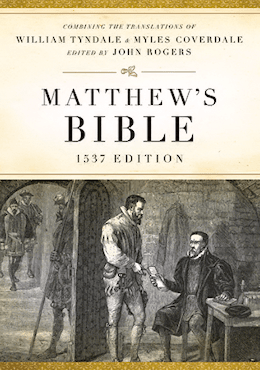Textus Receptus Bibles
Matthew's Bible 1537
| 6:1 | Wherfore let vs loue the doctrine pertaininge to the beginninge of a Christen man, & let vs go vnto perfeccion, & nowe no more lay the foundacion of repentaunce from deade workes, and of faythe towarde God, |
| 6:2 | of baptyme, of doctryne, and of layinge on of handes, and of resurreccion from death, and of eternal iudgemente. |
| 6:3 | And so wil we do, yf God permytte. |
| 6:4 | For it is not possible that they whiche were ones lyghted, and haue tasted of the heauenly gyft, and were become partakers of the holy ghoste, |
| 6:5 | and haue tasted of the good worde of God, and of the worlde to come: |
| 6:6 | yf they fall, shoulde be renued agayne vnto repentaunce: for as muche as they haue (as concernynge them selues) crucifyed the sonne of God a freshe makynge a mocke of hym. |
| 6:7 | For that earthe whiche drincketh in the rayne whiche commeth ofte vpon it, and bryngeth forth herbes mete for them that dresse it, receyueth blessynge of God. |
| 6:8 | But that ground which beareth thornes and bryars, is reproued, and is nye vnto curssynge: whose ende is to be burned. |
| 6:9 | Neuerthelesse deare frindes, we truste to se better of you, and thynges whiche accompanye saluacyon, though we thus speake. |
| 6:10 | For God is not vnryghtuous that he should forget your worke and laboure that procedeth of loue, which loue you shewed in hys name, whiche haue mynystred vnto the saynctes, & yet mynyster. |
| 6:11 | Yea, and we desyre that euerye one of you shew the same dylygence, to the stablyshynge of hope euen vnto the ende: |
| 6:12 | that ye faynt not, but folowe them, whiche thorowe fayth & pacience inheret the promyses. |
| 6:13 | For when God made promes to Abraham, because he had no greater thynge to sweare by, he sweare by hym selfe, |
| 6:14 | saiynge: Surelye I wyl blesse the, and multyplye the in deede. |
| 6:15 | And so after that he had taryed a longe tyme, he enioyed the promes. |
| 6:16 | Men verelye sweare by hym that is greater then them selues, & an othe to confyrme the thynge, is amonge them an ende of all stryfe. |
| 6:17 | So God wyllynge verye aboundauntlye to shewe vnto the heyres of promes, the stablenes of hys counsayle, he added an othe, |
| 6:18 | that by two immutable thynges (in which it was vnpossyble that GOD shaulde lye) we myghte haue perfecte consolacyon, whiche haue fled, for to holde faste the hope that is set before vs, |
| 6:19 | whiche hope we haue an ancre of the soule both sure and stedfast. Whiche hope also entreth in, into those thynges that are wythin the vayle, |
| 6:20 | whether the fore runner is for vs entred in I meane Iesus that is made an hye prieste for euer, after the order of Melchysedech. |

Matthew's Bible 1537
The Matthew Bible, also known as Matthew's Version, was first published in 1537 by John Rogers, under the pseudonym "Thomas Matthew". It combined the New Testament of William Tyndale, and as much of the Old Testament as he had been able to translate before being captured and put to death, with the translations of Myles Coverdale as to the balance of the Old Testament and the Apocrypha, except the Apocryphal Prayer of Manasses. It is thus a vital link in the main sequence of English Bible translations.